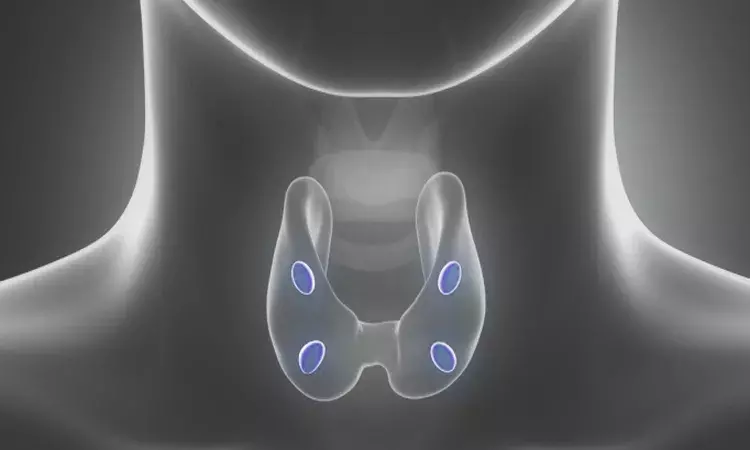- Home
- Medical news & Guidelines
- Anesthesiology
- Cardiology and CTVS
- Critical Care
- Dentistry
- Dermatology
- Diabetes and Endocrinology
- ENT
- Gastroenterology
- Medicine
- Nephrology
- Neurology
- Obstretics-Gynaecology
- Oncology
- Ophthalmology
- Orthopaedics
- Pediatrics-Neonatology
- Psychiatry
- Pulmonology
- Radiology
- Surgery
- Urology
- Laboratory Medicine
- Diet
- Nursing
- Paramedical
- Physiotherapy
- Health news
- Fact Check
- Bone Health Fact Check
- Brain Health Fact Check
- Cancer Related Fact Check
- Child Care Fact Check
- Dental and oral health fact check
- Diabetes and metabolic health fact check
- Diet and Nutrition Fact Check
- Eye and ENT Care Fact Check
- Fitness fact check
- Gut health fact check
- Heart health fact check
- Kidney health fact check
- Medical education fact check
- Men's health fact check
- Respiratory fact check
- Skin and hair care fact check
- Vaccine and Immunization fact check
- Women's health fact check
- AYUSH
- State News
- Andaman and Nicobar Islands
- Andhra Pradesh
- Arunachal Pradesh
- Assam
- Bihar
- Chandigarh
- Chattisgarh
- Dadra and Nagar Haveli
- Daman and Diu
- Delhi
- Goa
- Gujarat
- Haryana
- Himachal Pradesh
- Jammu & Kashmir
- Jharkhand
- Karnataka
- Kerala
- Ladakh
- Lakshadweep
- Madhya Pradesh
- Maharashtra
- Manipur
- Meghalaya
- Mizoram
- Nagaland
- Odisha
- Puducherry
- Punjab
- Rajasthan
- Sikkim
- Tamil Nadu
- Telangana
- Tripura
- Uttar Pradesh
- Uttrakhand
- West Bengal
- Medical Education
- Industry
Advanced Computed Tomographic more sensitive in localizing Primary Hyperparathyroidism: Study

Primary hyperparathyroidism (PHPT) is a common endocrine disorder. Preoperative localization has traditionally been accomplished through imaging modalities such as ultrasonography and technetium-99m sestamibi with or without single-positron emission computed tomography (SPECT). Historically, these modalities have been used in conjunction with a single-phase, contrast-enhanced CT to assist with surgical anatomy and operative planning, hence the combined term "sestamibi-SPECT/CT."
An important advance occurred with the introduction of 4-dimensional computed tomography (4D-CT), which is a multiphase CT used to localize hyperactive parathyroid tissue. This imaging protocol scans from the mandible to the upper mediastinum, in a 4-image acquisition series at specific time intervals: before intravenous contrast, and in arterial, venous, and delayed contrast-enhanced phases.
Dual-energy computed tomography (DECT) is an alternative imaging modality that has been recently described as a localization tool for PHPT. Dual-energy computed tomography essentially evaluates tissues at 2 different x-ray energies and then uses sophisticated computer algorithms to generate virtual post processing images, which eliminates the need for the additional image acquisitions and extra radiation that comes with the 4D-CT scan.
In this systematic review by Nrusheel Kattar and team, both qualitatively and quantitatively compared emerging CT localization techniques for patients with PHPT. The diagnostic performance of these techniques were contrasted with the current first-line standard of sestamibi-SPECT/CT.
Study included comparative observational studies but excluded animal studies, case reports, and case series. Overall, 353 abstracts were screened independently by 2 investigators along with a third reviewer to resolve conflicts. A total of 26 full-text articles were included in this review. Measures of imaging diagnostic performance such as sensitivity, specificity, positive predictive value, and negative predictive value were the primary outcomes of interest.
Overall, of 34 articles screened, 26 met criteria for qualitative synthesis, and 23 of these were appropriate for meta-analysis. Of the 26 studies included, there were 5845 patients, of which 4176 were women (79.2%). The average of mean ages reported in 23 studies was 60.9 years.
Meta-analysis in all patients with PHPT revealed pooled sensitivity that was greater with 4D-CT (81%; I 2 = 88%) compared with the current first-line modality of sestamibi–single-photon emission CT (SPECT/CT) (65%; I 2 = 93%). For patients with recurrent PHPT requiring reoperation, 4D-CT pooled sensitivity was 81% ( I 2 = 93%) in contrast to 53% (I 2 = 81%) for sestamibi-SPECT/CT. The overall quality of the 26 studies was moderate with a median (range) Methodological Index for Nonrandomized Studies score for all included studies of 15.5 (13-19).
Four-dimensional CT, DECT, and PET/CT are emerging advanced localization techniques for patients with PHPT. Although DECT and PET/CT need further study to confirm promising initial results, the findings of this systematic review and meta-analysis of numerous studies from the past decade suggest that the 4D-CT can be more sensitive and specific than sestamibi-SPECT/CT in localizing PHPT. More research is needed, ideally with standardized imaging protocols, to determine the clinical significance of this improvement in localization. The decision to use 4D-CT as a first-line tool over sestamibi SPECT/CT remains one of surgeon preference in concordance with availability, insurance reimbursement considerations, and institutional policy.
Source: Nrusheel Kattar, MD; Matthew Migneron, MD; Michael S. Debakey et al; JAMA Otolaryngol Head Neck Surg. doi:10.1001/jamaoto.2022.0271
Dr Ishan Kataria has done his MBBS from Medical College Bijapur and MS in Ophthalmology from Dr Vasant Rao Pawar Medical College, Nasik. Post completing MD, he pursuid Anterior Segment Fellowship from Sankara Eye Hospital and worked as a competent phaco and anterior segment consultant surgeon in a trust hospital in Bathinda for 2 years.He is currently pursuing Fellowship in Vitreo-Retina at Dr Sohan Singh Eye hospital Amritsar and is actively involved in various research activities under the guidance of the faculty.
Dr Kamal Kant Kohli-MBBS, DTCD- a chest specialist with more than 30 years of practice and a flair for writing clinical articles, Dr Kamal Kant Kohli joined Medical Dialogues as a Chief Editor of Medical News. Besides writing articles, as an editor, he proofreads and verifies all the medical content published on Medical Dialogues including those coming from journals, studies,medical conferences,guidelines etc. Email: drkohli@medicaldialogues.in. Contact no. 011-43720751


